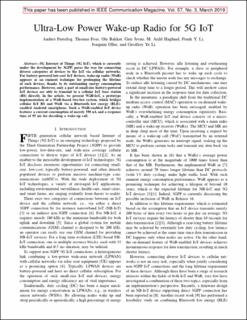| dc.contributor.author | Frøytlog, Anders | |
| dc.contributor.author | Foss, Thomas | |
| dc.contributor.author | Bakker, Ole Alexander | |
| dc.contributor.author | Jevne, Geir | |
| dc.contributor.author | Haglund, Magne Arild | |
| dc.contributor.author | Li, Frank Yong | |
| dc.contributor.author | Oller, Joaquim | |
| dc.contributor.author | LI, Geoffrey Ye | |
| dc.date.accessioned | 2020-05-29T13:38:11Z | |
| dc.date.available | 2020-05-29T13:38:11Z | |
| dc.date.created | 2019-02-17T08:25:26Z | |
| dc.date.issued | 2019 | |
| dc.identifier.citation | Frøytlog, A., Foss, T., Bakker, O.A., Jevne, G., Haglund, M.A., Li, F.Y., Oller, J. and Li, G.Y. (2019) Ultra-Low Power Wake-up Radio for 5G IoT In: IEEE Communications Magazine. 2019, 57 (3), 111-117. DOI: | en_US |
| dc.identifier.issn | 0163-6804 | |
| dc.identifier.uri | https://hdl.handle.net/11250/2656058 | |
| dc.description.abstract | 5G Internet of Things (5G IoT), which is currently under development by 3GPP, paves the way for connecting diverse categories of devices to the IoT via cellular networks. For battery-powered low-cost IoT devices, wake-up radio (WuR) appears as an eminent technique for prolonging the lifetime of such devices, thanks to its outstanding energy consumption performance. However, only some small-size battery-powered IoT devices are able to transmit to a cellular IoT base station (BS) directly. In this article, we present W2B-IoT, a prototype implementation of a WuR-based two-tier system, which bridges cellular IoT BS and WuR via a Bluetooth low energy (BLE)-enabled Android smartphone. Such a WuR-enabled IoT device features a current consumption of merely 390 nA and a response time of 95 ms for decoding a wake-up call. | en_US |
| dc.language.iso | eng | en_US |
| dc.publisher | IEEE | en_US |
| dc.relation.uri | https://ieeexplore.ieee.org/document/8642801 | |
| dc.title | Ultra-Low Power Wake-up Radio for 5G IoT | en_US |
| dc.type | Journal article | en_US |
| dc.type | Peer reviewed | en_US |
| dc.description.version | acceptedVersion | en_US |
| dc.rights.holder | Copyright © 2019, IEEE | en_US |
| dc.subject.nsi | VDP::Technology: 500::Information and communication technology: 550 | en_US |
| dc.source.pagenumber | 111-117 | en_US |
| dc.source.volume | 57 | en_US |
| dc.source.journal | IEEE Communications Magazine | en_US |
| dc.source.issue | 3 | en_US |
| dc.identifier.doi | 10.1109/MCOM.2019.1701288 | |
| dc.identifier.cristin | 1677981 | |
| cristin.qualitycode | 2 | |
